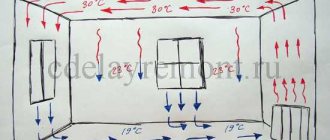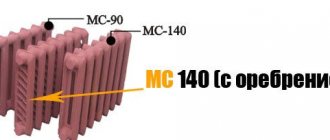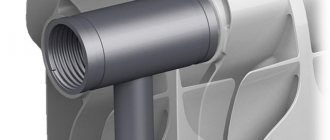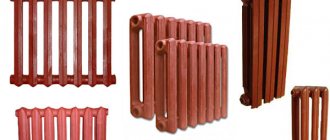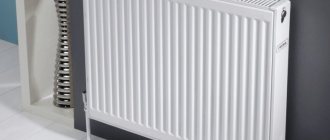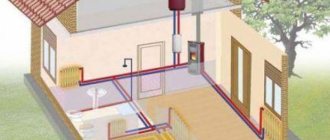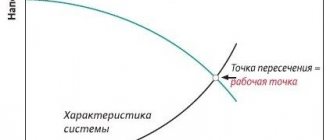The heating process using infrared radiation occurs due to its physical properties. Mainly such as reflectivity, absorption ability of various surfaces and substances, transmission, dispersion, etc. For example, air consists of nitrogen and oxygen molecules, almost does not absorb, but partially scatters and easily transmits such radiation. The human body, like any objects in the room, mostly absorbs electromagnetic waves from this part of the spectrum, only partially reflecting them.
The principle of heating using infrared radiation
In the process of infrared radiation, electromagnetic energy is transformed into thermal energy. Thus, any objects in the room, when heated, give off this energy to the air, as a result of which it is heated.
With infrared heating, conversion flows reduce their speed by an order of magnitude, and the rays, hitting the human body, activate its peripheral circulatory system, which causes thermal comfort 3-4 °C earlier than with conventional heating with convectors. Being the most useful part of the solar spectrum, the emitted rays compensate for the “solar hunger”.
That is, any heated object is a source of infrared radiation. The wavelength of such radiation is determined by the molecular composition and temperature of the object. The amount of energy received depends on this.
Another example of such heating is the Sun, which warms our Earth. This is the most powerful source in the solar system. The sun is its natural heater.
Everything living on Earth vitally needs solar warmth, and humanity is no exception. Infrared rays from the sun travel billions of kilometers through space with minimal loss. Any surface encountered on their path heats up, absorbing the energy of the rays and turning into heat.
Infrared Heating Basics
Long waves are the most comfortable for people. Since the range of infrared radiation itself is quite large, scientists divided it into three subranges:
- Short - it is adjacent to the visible part of the world.
- Average.
- Long.
The hottest objects emit shorter wavelengths. The warmer the object, the shorter the wave.
PLEN heating is an alternative to the outdoor heating system used by nature.
The PLEN system, mounted on the ceiling, allows you to obtain thermal comfort in the same way that the Sun gives it to all living things. Long-wave radiant energy emitted by heating elements heats objects, floors, cars, which, in turn, accumulate it and then release it into the environment. At the same time, air humidity remains natural.
That is, the meaning of what has been said comes down to the fact that in order for the room to become warm, it is not at all necessary to heat the air in it.
What is PLEN and how does it work?
PLEN stands for “film radiant electric heater.” This is an infrared heating system consisting of a resistive radiating element located between polymer films. The basis of the PLEN system is the interaction of infrared radiation with various matter and its physical properties.
It is called a resistive element because it consists of several layers of resistor circuits (resistances).
When PLEN heating is connected to the electrical network, an electric current begins to pass through the resistors, and they heat up to a fairly high temperature - 40-50°C. At the same time, the material from which the resistors are made can emit infrared radiation. And in order for it to be used to heat the room, before laying the PLEN, foil is placed on the side of the ceiling, walls, floor or other surface, which reflects the directed rays.
The heating time of the resistor film takes less than 10% of the time required to warm up the entire room. Within 1-2 hours, the temperature increases by 10 degrees - this is the minimum interval. Then the PLEN heating system continues to maintain the set temperature and turns on periodically for 3-15 minutes every hour.
Even the best heater will not work properly if it is not managed correctly.
The PLEN heating system, as a rule, consists of a heater and a control unit. The required temperature is set using a thermostat. The thermostat installed in the room itself monitors the temperature surrounding it using a built-in temperature sensor and controls a special unit according to the difference between the actual and set values it detects.
In addition, if the room is properly insulated, then PLEN consumes less electricity.
Two pipes or one
Single-pipe wiring
In this case, the “supply” and “return” are organized using a single looped pipeline. With this scheme, radiators are placed in series, and water passes through them in order. This is the easiest way to implement heating and the most budget-friendly. However, some problems arise during heat distribution, because as the coolant moves, it consumes its thermal energy, and the latest heating devices often turn out to be too cold. Therefore, the single-pipe scheme is mainly used in small houses.
Two-pipe wiring
All types of two-pipe heating system wiring have a supply pipe and a return pipe. This method of implementation is more expensive, but a number of restrictions are removed, for example on the number of batteries in the circuit. The homeowner can easily regulate the flow of coolant through each radiator, including the use of automatic locking devices with temperature sensors. All known pipe routing methods become available.
Application and installation of PLEN
There are no special restrictions on the use of PLEN. It is used both as primary and additional heating.
Can be installed on the floor, walls, ceiling. When using PLEN heating as the main heating, user reviews confirm this, it is enough to cover only 75% of the ceiling or floor. They heat apartments, cottages, industrial premises, offices, loggias, etc.
PLEN shows the greatest efficiency in places where there is maximum air exchange.
PLEN for private houses
Infrared heaters are suitable not only for new buildings, but also for the reconstruction of existing ones.
By choosing PLEN heating, you will be able to save significantly already at the design stage. There is no need to build a special boiler room or allocate one of the rooms of the house for it. You also don’t have to think through a fuel storage scheme, be it coal, firewood or diesel fuel.
There will never be a smell of burnt coal or diesel fuel in the house. In addition, the appearance of the house will not be spoiled by radiators and pipes protruding from the walls, which are inherent in traditional heating. And most importantly, IR heaters will remove dampness in the shortest possible time, maintaining a comfortable temperature in all individual rooms.
Material for water pipes
Since water supply risers belong to the water supply system of an apartment building, any available water pipes are suitable for riser pipes. Namely,
- metal-polymer pipes (SP 40-103-98);
- galvanized steel water and gas pipes (GOST 3262-62),
- seamless steel cold/heat-drawn, cold/warm-rolled pipes (GOST 8733-66) with protective coatings against corrosion;
And also, according to SNIP 2.04.01-85:
- plastic pipes made of polyethylene, polypropylene, polyvinyl chloride, polybutylene;
- fiberglass pipe
- pipes made of other plastics.
In addition, pipes (according to SNIP 2.04.01-85) from:
Copper, bronze and brass.
As you can see, according to the standards, water supply risers in an apartment building can be installed from any water pipes.
The same statement applies to replacing riser pipes (risers) in a single apartment.
Requirements for installation of PLEN
- Mechanical impact on the device is prohibited.
- The building (or premises) must comply with the requirements of SNIPs in terms of thermal insulation.
- Installation should only be carried out by a qualified electrician.
- It is prohibited to lengthen or shorten the PLEN.
- It is prohibited to operate the device rolled up.
- It is forbidden to disassemble PLEN film heating.
- The surface must be leveled and free of dust and dirt.
- Contact of PLEN with aggressive chemical media is unacceptable.
- Installation can only be carried out when the network is de-energized.
- Single-phase input is used only with a total power of up to 5 kW. For higher power, a three-phase input should be used.
PLEN heating: characteristics and advantages
- Installation and dismantling for reinstallation to another location is minimally simple.
- PLEN is equipped with a fire safety system.
- It operates silently and does not create unpleasant vibrations.
- At a minimum, PLEN heating works for up to 25 years, if the rules for its installation are followed correctly.
- Oxygen is not burned and does not in any way affect the change in room humidity.
- Does not require maintenance.
- Heating costs are 70% lower when comparing this heating system with others.
- Payback of the system in 2 years, including installation costs.
- Calmly relates to voltage fluctuations.
- Short heating time for floors after switching on.
- Eco-friendly and takes up virtually no space in the room;
- PLEN heating has a significantly lower electromagnetic field than that of household appliances, which is within the normative background.
- Automated and easily customizable.
- Standby mode is about +10˚С.
- Easily decorated with any non-metallic materials.
- Radiation is beneficial for the immune system and also ionizes the air in the room.
- Since the floor is always warm, the system is a preventative against colds.
Price
If there is a question about a heating system from scratch, then you can focus on comparative tables for the Moscow region:
| Costs for a house of 150 square meters, rubles | Gas | Diesel | Solid fuel boiler | PLEN |
| Design work | 40000 | 40000 | 40000 | – |
| Installation | 120000 | 120000 | 120000 | 120000 |
| Commissioning | 40000 | 40000 | 40000 | 40000 |
| Equipment price | 360000 | 320000 | 300000 | 340000 |
| Total | 560000 | 520000 | 500000 | 500000 |
| Operating costs, rubles | Gas | Diesel | Solid fuel boiler | PLEN |
| Gas consumed, purchase of pellets, diesel fuel per month | 1600 | 2400 | 1600 | 1200 |
| Costs for the heating season (6 months) | 9600 | 14400 | 9600 | 7200 |
| Repair and maintenance costs per season | 1600 | 1600 | 1600 | – |
| Total for 1 year of operation | 13200 | 16400 | 13200 | 7200 |
| Total for 5 years of operation | 66000 | 82000 | 66000 | 36000 |
The cost of equipment increases if:
- The room area is large and a film of maximum size is required.
- There is additional protection from moisture and dust (sauna, greenhouse).
- Maximum sheet thickness required (increased power).
There is no point in looking for imported goods. This is a domestic development, so our quality is better.
These calculations confirm that the one-time costs of replacing a heating system are impressive, but the payback occurs in 2-3 years. Considering the durability and ease of use, the economic benefits are obvious.
Impact on human health
Research conducted by scientists has shown that long-wave infrared radiation has the most beneficial effect on the human body, and in particular its part adjacent to the middle sub-range is the “rays of life”, the wavelength of which is from 5 to 15 microns. It is precisely in this gap that PLEN infrared heating works. Thermal radiation of the human body is also in this range.
Back in the sixties, Japanese scientists, based on these discoveries, patented specially designed emitters, which were subsequently used in infrared saunas. For decades, scientists have conducted joint research and proven the benefits of procedures obtained in infrared cabins. Infrared therapy appeared.
Thanks to her, PLEN heating also appeared. Reviews from those who have used this heating system show that it has proven to be an effective and quite effective way to combat not only colds, but also excess weight problems. It also perfectly stimulates the activity of the stomach and helps get rid of cellulite.
Accordingly, any talk about the dangers of infrared radiation for human health is a fantasy, and nothing more.
PLEN - home heating, comparable to heating with light rays. Achieving uniform, comfortable lighting in a room can only be achieved by correctly distributing light sources.
The same applies to infrared emitters. When designing an infrared heating system, you should rely on the height of the ceilings, the type of room itself and its area. Then you won’t have to complain about uneven heating later.
Those who are faced with the intention of creating an autonomous heating system in a private home are probably familiar with the concept of infrared heating. Plen heating, do-it-yourself installation, is a fairly new method of heating a room, and is increasingly gaining popularity. Therefore, manufacturers are trying to increasingly modernize the system and develop modern models.
Infrared heaters
Characteristic features of operation: after receiving heat energy from the heating element, the heater radiates it to all surfaces around: floor, walls, ceiling, furniture, and so on. As a result, the surfaces heat up and heat is released from them into the air.
The radiated heat from such heaters is similar to sunlight and is not absorbed by the air. Therefore, all the heat from the devices reaches the surfaces without loss.
It is very important that infrared heaters manage to avoid the irrational division of temperature that occurs when using traditional heating devices and systems, with heat rising to the ceiling, displaced by cooler air currents.
Comparison of conventional convective and infrared heating
That is, the energy of these heating devices is used to heat objects, not air. The air has the same temperature both on the floor surface and under the ceiling, while energy savings are about 70%. Heating a house with infrared heaters allows you to create zonal or even spot heating.
pros
- Long operational period. Infrared heaters do not have any parts that wear out (break, burn out) and require periodic replacement.
- Cost-effective installation. This is primarily due to the fact that the installation does not require the development of design documentation. By the way, its cost can be 35–40% of all expenses. And the installation itself does not present any difficulties.
- Almost complete absence of inertia. The premises are heated in the shortest possible time, which is very convenient for owners of country houses, dachas or other real estate.
- Infrared heaters do not dehumidify the air, like reflectors.
- Possibility of organizing zone heating. This is one way to save on heating costs for the entire building.
- Uniform heating of the room throughout the entire volume.
- Quiet operation. Installing such devices eliminates the “pleasure” of hearing periodic water hammer in the water system (when it becomes airy), the hum of a fan, and so on.
- When installing the heater on the ceiling, you do not have to install a heated floor circuit. Its coating will always be heated to a certain temperature. For families with small children this is a significant plus.
- Operational safety. During operation, infrared heaters do not require “supervision”; they cannot self-ignite, so it is recommended to install them where fire inspection authorities impose the most stringent requirements, the implementation of which is not always possible or requires significant costs.
- The beneficial effects of infrared radiation on the human body are considered another significant advantage of such devices. In addition, waves of this spectrum are capable of destroying various bacteria (microorganisms) on the surfaces to which the screen is facing. And “pests” are always present in any room.
- The absence of any secretions in the form of toxins, specific odors and, as a result, side effects - insomnia, headaches, and the like.
- Space saving due to the possibility of fixing heaters on walls or ceilings.
- If we compare the arrangement of heating in this way with a water system, then the big advantage is that you do not have to equip a mini-boiler room (furnace), lay pipes, install a pump, expansion tank and shut-off valves.
- Maintenance is not provided for IR heaters. So, another one in the “pluses” column.
Ceiling heaters
When installing infrared heating in this case, it is necessary to take into account the height of the suspension, most often it is 2.2-3.5 meters from the floor, it depends on the height of the ceilings. But it is not advisable to point such devices at a person’s area, especially where the head is located.
Ceiling infrared heater
You cannot hang the heater above the bed so that it is directed at the head; it is best to point it at the torso and legs. It is not advisable to install them near windows, as heat will be lost. It is also not recommended to install infrared heaters on PVC ceilings.
Warm floor
This is one of the types of infrared heating. The “warm floor” system can be installed under laminate, carpet, linoleum, parquet, ceramic tiles, and stone materials.
The advantages that such an infrared heating system provides:
- not afraid of damage. Mechanical impact will not lead to failure;
- low power consumption. Approximately 60 W/m2 per hour, when covering only 70-80% of the floor surface;
- comfort and feeling of coziness;
- does not dry out the air, creates a good microclimate in the room, like in the sun in summer;
- silent, heat comes immediately after switching on;
- insensitive to voltage surges in the network, which happens quite often in our country.
Installing infrared heating with your own hands is not at all difficult; you do not need any special education or equipment. Since this is an electrical appliance, it is possible to connect it to the “Smart Home” system, in this case the heating will turn on and work according to the set timer using the control panel or computer at the touch of a button, even after a call from a mobile phone.
Warm film infrared floor (PlEn)
Disadvantages of an infrared heating system:
- Heaters installed on the ceiling have the following disadvantage: they do not always fit into the interior and are difficult to hide. They look rather unnatural;
- if you intend to install them in office premises, you will need permission from the fire service, and this will require an unnecessary waste of money;
- if this system is installed in several rooms, then there is no need to talk about energy savings, although if you calculate infrared heating, the cost figures will be less than with cable and water heating;
- high price.
Features of using such a heating system in practice
Even taking into account all the shortcomings, this system is the safest and most effective. It is good to install heating film on the ceiling, but they also work well with floor coverings.
But the infrared floor does not always give off heat equally; when using linoleum and carpet, the radiation is least delayed. They almost do not accumulate heat, thereby warming up the room much better. The most effective film is with ceramic tiles, and a little weaker with laminate.
It is necessary and quite attentive to the selection and installation of furniture in the room; this must be done even before installing the heating system, having thought through every little detail. Where furniture will be placed, it is irrational to lay the film, this will reduce heat transfer and have a negative impact on the condition of the furniture; it will be susceptible to drying out.
Also, infrared heating can be made on the basis of carbon film. It is very important to carry out the installation and installation of the system, observing all safety measures. It is best to entrust the connection of the switchboard itself to a professional electrician who has the appropriate clearance group.
1Drevo.ru « Heating and Communications
Plan is a film-radiant electric heater. Another product from the field of innovation in heating systems. It consists of flexible plates penetrated with carbon resistors or metal elements.
Alternatively, aluminum foil can be used. The operating principle of the heater is infrared radiation. The design is simple, but has mixed reviews. What makes owners delighted or, conversely, indignant about the acquisition is described below.
Opinions about Plan
Yes, plan heating receives mixed reviews, which you need to focus on by studying the new system in detail. So:
"The advertisement is engine of the trade. Succumbing to the colorful descriptions of its advantages, we purchased and installed the system. Not to say that it turned out to be very expensive, but the ceiling heater did not justify itself - it was not comfortable in the house, and given our Siberian cold, the effect is completely sour - you will not sleep on the ceiling. Left as an addition to the electric boiler.”
“We are pensioners, so maintaining heating with a coal and wood stove became more and more problematic for us every year - it takes effort, and fuel is expensive now. The children set up the Plan system for us. At first we thought it wouldn’t work – my grandfather especially cursed, he was sorry for the money. Now nothing - silent. Yes, it’s true - our house is small, we rarely leave it, when we come, it’s warm and dry inside. There’s no dust or soot, there’s no need to chop wood or carry coal, just sit and watch TV.”
Anna Ivanovna and Pyotr Stepanovich, Tobolsk
“I’ve been looking at infrared emitters for a long time - I wanted to buy one for my home. However, there were doubts that we would have to install additional heating, since our area is large - 200 m². I didn’t think that small point devices would be enough for the whole house. When I accidentally came across a description of the Plan, I didn’t think twice about it - sheets up to 5 m long will allow you to heat the house everywhere. They called a team for installation because they were afraid of accidentally damaging the heating plates. DIY installation is also possible. Now I don’t regret anything - I don’t need additional heating, it’s dry and good.”
So, the Plan heating system seems to be a benefit to one user, but not to another. Why is this happening? Let's look at the operating principle of Plan, as well as the pros and cons of the installation.
Reviews
“I watched an advertisement on TV and decided to install a ceiling-type heater in my new house. Unfortunately, he immediately disappointed me. An oil-fired radiator produces much more heat for the same power consumption than its infrared counterpart, the heat from which could only be felt by standing directly next to it.”
“What was captivating was that installing a film-radiant heating system is not difficult, even on your own. The main thing in this matter was to follow the instructions and follow the sequence of assembly operations. In practice, it turned out that in our latitudes, with rather harsh winters, this type of heating cannot be an alternative to more powerful boiler heating. But it has fully justified itself as an additional heating system, which effectively copes with maintaining a comfortable temperature after the house has already been heated by the main system. For example, I first turn on the boiler to warm up the building, then turn it off, and the PLEN system maintains a constant temperature in the home of about 22 degrees. In case of severe frosts, of course, you have to turn on the boiler heating, but still, the lion’s share of the cold period can be easily survived using an alternative heating system.”
“After much hesitation, I installed PLEN as an additional heating system. Before that, I used a gas boiler all the time, but due to frequent travel for work, its use became unprofitable, especially in winter, because I’m not at home, but the boiler is working. So I came up with the idea of installing film heating with a thermostat, because it is absolutely safe, which means you can safely turn it on to minimum and go on a business trip, and heating costs are now lower and the house will not freeze.
Plan system - advantages and disadvantages
Pros and cons accompany all heating systems that currently exist. To have a clear idea of the advantages of Plan, they need to be considered in comparison with other heating systems. Details in the table:
| Solid fuel boiler | Electrical unit | Plan system |
| Efficiency – 85-90% | Low efficiency – 30% | Efficiency – 89% |
| Circulation of combustion products throughout the house | Dust attraction | Maintaining an optimal climate without a dry atmosphere |
| High fuel costs | Very high energy costs - up to 80 thousand rubles/season | Expenses for the season within 20 thousand rubles |
| Lack of adjustment unit | Adjustment provides savings of 10-15% | Economy mode allows you to save energy resources by 30-35% |
| Fire hazard | Security is low | High safety due to low heating temperature |
| Physical effort and regular prevention. Preparing for the heating season | Constant monitoring, maintenance, equipment costs and prevention | No preparation for the season is required, as well as repairs and maintenance - turn it on and off |
| Service life – 10-15 years | Service life – up to 10 years | 50 years – minimum |
| Long process of warming up the room | Warming up is not fast | Quick heating of the room - 40-60 minutes |
| The area of the room has been significantly reduced | Reducing usable area | The system is mounted on the ceiling and does not affect the amount of usable space |
In addition to the described advantages, we can add that the system was made in Russia and has a quality mark. Installation is carried out by craftsmen on any area within a few days. Upon completion of the work, the team confirms the guarantee of use without any problems for 10-25 years.
It would be wrong not to point out any shortcomings of the system. They are as follows:
- If the user is dissatisfied with the maintenance of the energy network in principle - sudden surges, voltage drops, then, naturally, this will affect the system. Fortunately, these problems are rare.
- Careful calculation of plates for the entire house is required. If heat loss is significant, then a separate power supply unit is required for high-quality operation of the coating. It is possible to install it; you only need permission from the local monopoly.
- Installed plan heating must be finished with your own hands - it is not recommended to leave it this way due to visual discomfort. Moreover, in itself it is not very presentable.
As you can see, all the shortcomings are easily eliminated. If the home owner does not have experience in installing this type of heating system, then be sure to contact professionals, and then all the advantages of use will manifest themselves to the fullest.
Grade
Advantages
Why is a radiant heating system better than a sequential one? Here is a typical list of arguments of its supporters:
- Minimum temperature spread between heating devices. They are powered from a common collector and are fed from one supply thread;
- Ease of management. From the manifold cabinet you can change the temperature of any part of the heating system;
The manifold cabinet is the heating control unit for the entire house.
- Independent temperature control of devices. If you cover or completely turn off any of them, this will not affect the operation of the remaining batteries;
- Hidden liner routing. When laid in a screed or grooves, they will not spoil the design of the living space.
The heating connections will be hidden by the floor laid over the joists.
Flaws
First, a few critical comments on the properties of collector wiring that I mentioned among its advantages.
- In a two-pipe series system, it is also possible to obtain the same temperature of the batteries. With dead-end wiring, it is achieved by balancing the system (that is, throttling the connections of the batteries closest to the boiler); with parallel wiring, the temperature on all heating devices will be the same without balancing;
Tichelman loop, or a two-pipe system with associated coolant movement. The temperature of all radiators is the same without balancing.
- It is most convenient to control the air temperature in the room directly from it. If you need to go through the whole house to the collector cabinet in order to reduce the heating of the battery, this, you see, does not look like an advantage at all;
- Independent temperature control of radiators is possible in any two-pipe system. With single-pipe wiring, this is also achievable: it is enough to connect the batteries not into the filling gap, but parallel to it.
Connecting a radiator parallel to the filling in a single-pipe Leningrad tank. Taps on the inlet allow you to reduce the heating of the battery without affecting the operation of other heating devices.
And the actual disadvantages:
- Expensive. The total length of the heating connections in the case of radial pipe distribution will be several times greater than when the batteries are connected in series;
- Difficult. Grooving walls or pouring screed with collector wiring is possible only at the stage of major renovation of a private house or apartment. Meanwhile, it is possible to sequentially separate the batteries even after finishing the final repairs: the only dirty work to be done is drilling the walls for bottling;
Heating with serial connection of radiators can be installed after finishing finishing.
Unreliable. The heating system requires a circulation pump to operate, which makes it energy-dependent. When circulation stops (for example, in the event of a long power outage), the water in the pipes will freeze. It is much more difficult to warm up connections hidden in the floor or walls than openly laid outlets.
The line below the connection to the radiator is filled with water. It is impossible to drain it completely.
conclusions
In my opinion, radiant wiring is justified only in one case: if you are installing water-heated floors.
Arguments? At your service:
- The length of one heated floor circuit cannot exceed 120 meters due to the high hydraulic resistance of the pipes, so in any case there will be several parallel circuits in the house;
- It is most convenient to connect parallel circuits to the terminals of the distribution manifold. Alternative installation methods involve open laying of bottlings and open installation of chokes or thermal heads, which, as you understand, goes against aesthetics.
Water heated floor: collector wiring is completely justified.
A high-temperature radiator heating system is cheaper, easier and smarter to install in series.
Technical characteristics of Plan
First of all, the user should pay attention to the following parameters:
- Power. It’s a good idea to know your own heat loss at home. In this case, not only the number of windows and doors is taken into account, but also the construction material. In addition, you need to take into account the presence of insulation. As a rule, negative reviews are left by owners who have not properly insulated their own home.
- Required voltage. It is better if there is a separate input for heating with a power cable and grounding. The risk of damage to the unit due to interruptions is reduced, as is the general danger of using electricity.
- Efficiency It is different for different models. Film options always delight buyers with a high value - up to 90%. Of course, the level depends on correct installation and compliance with the two previous points.
- Heating temperature. Infrared emitters are considered low-temperature - models that burned dust and oxygen are no longer produced. The plan is not capable of setting fire to the ceiling or floor covering - this should not be an issue.
Depending on the length and width of the sheet, the parameters may vary. For example, Plan heating, the characteristics of which are maximum - plate length 5 m and thickness 0.5 mm, displays the following:
- Power up to 575 W;
- Efficiency – 90%;
- Heating temperature – up to 50⁰.
This will be enough to provide heat to a room whose area exceeds 20 m². In addition, alloy materials can withstand short-term humidity and do not contain harmful impurities for humans.
In addition to the described characteristics, the buyer must evaluate the condition of each plate - it must be without damage. It is possible that when switched on, a small web of cracks will appear on the surface of lavsan or plastic. There is no need to be afraid - this only speaks about the work of the conductors. It will be quite difficult to examine the cracks, so they will not pose a threat to the decorative appearance.
Coating IR film for ceiling outside
When choosing IR film for heating a room, you need to pay special attention to the quality of the system, which must meet a number of basic parameters:
- the base must be made of high quality film, the polymer used must be fireproof;
- the conductive strip must be undamaged and made of copper materials, the minimum permissible width must be 15 mm;
- the silver strip must have a clear outline, without gaps, and it must overlap the copper bus by 2 mm;
- the arrangement of carbon emitters should be striped or solid; geometric shapes do not have any effect on the operation of the ceiling heating system;
- the external lamination of the infrared film must be made of the same polymer as the base; it is not recommended to use materials with a smaller thickness;
- standard films must withstand temperatures up to +80 °C, high-temperature materials - up to +110 °C;
- if high quality materials were used in the production process, then there should be no deformation during operation;
- high-quality IR film should heat up evenly in a short period of time - about 5-10 seconds.
As practice shows, the wider the film, the lower the likelihood of it overheating during operation.
Important! If the polymer is transparent, then it deforms much faster during operation.
Installation of the Plan system
It is possible to install Plan ceiling heating only with working skills. It is fraught with the following difficulties:
- Plastic elements are mounted on a surface lined with a reflector. To do this, purchase a foil base. A steam membrane is ideal - it has a shiny surface on one side. It is worth carefully observing the position of the direction of the rays and preventing them from scattering outside the room.
- The strips are attached using plastic fasteners. However, the difficulty lies in not accidentally puncturing the strip of conductor through which current will flow if this happens. But with self-installation, everything is possible; you may have to replace the strip, and this is very expensive.
- The plates are fixed at a slight distance from each other. This will make it possible to achieve more uniform heating of the entire volume of the room. If the ceiling is a space separated by joists, then there is, of course, less maneuver for the location.
- The Plan film heating itself does not look very presentable, so it will have to be covered with some kind of decorative material. The ceiling space is covered with hanging material, plasterboard or tension fabric. It is important to ensure that materials do not come into contact with heaters.
When choosing plan heating for a specific room, the technical characteristics of each strip will be important - for dimensions 4 * 5 m, 3 plates 4 m long will be required.
The width, as a rule, is standard - 0.5 m. The total power will be equal to 1.2 kW/hour. Real consumption will be much lower - this means that the room will always be warm.
Every year, progress brings another innovation to the consumer in the form of a new invention that makes life easier for the owner of a private home. Film heaters have made a big breakthrough in this direction.
To summarize, we can say that PLEN infrared heating is a unique heat source. It has great advantages; it can be placed both in the emptiest area of the room and in the most active one - the system successfully works as a warm floor. Of course, purchasing this type of heating is not cheap, but in the end, the ease of use and advantages pay for the entire installation.
Total score: 0Votes: 0
Natural circulation of coolant
With natural circulation, the coolant moves through the system by gravity. This becomes possible due to the physical effect that manifests itself when the density of the liquid changes. Hot water has a lower density level. The liquid flowing through the reverse current has a high density, so it easily displaces water that has already heated up in the boiler. The heated coolant is directed upward through the system and then distributed through horizontal pipelines laid at a slight inclination of approximately 3-5 degrees. The presence of such a slope allows the coolant to move through the pipe on its own.
The heating design scheme, which is based on the natural circulation of liquid, is the most primitive, and therefore can be easily implemented in practice. In addition, to set up such a system there is no need to use other communications. It is worth noting that this option is only suitable for private houses with a small area, since the length of the system is limited to 30 meters. The disadvantages include the need to install pipes with a large diameter and a low level of pressure in the system.
